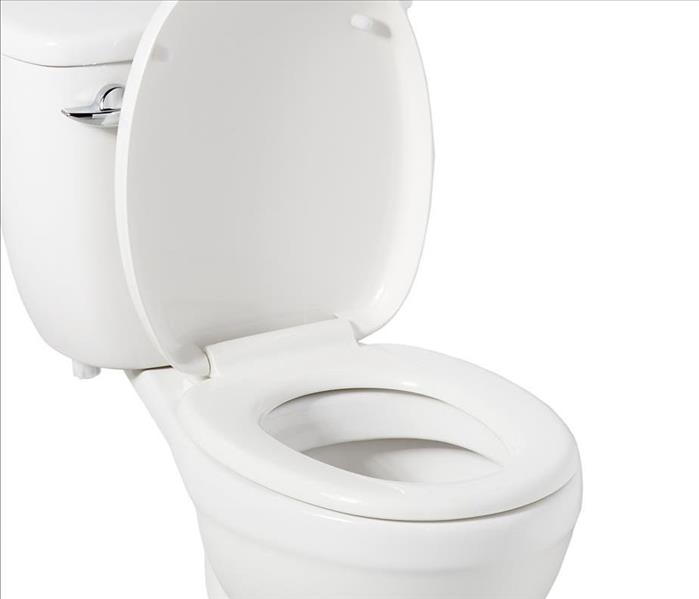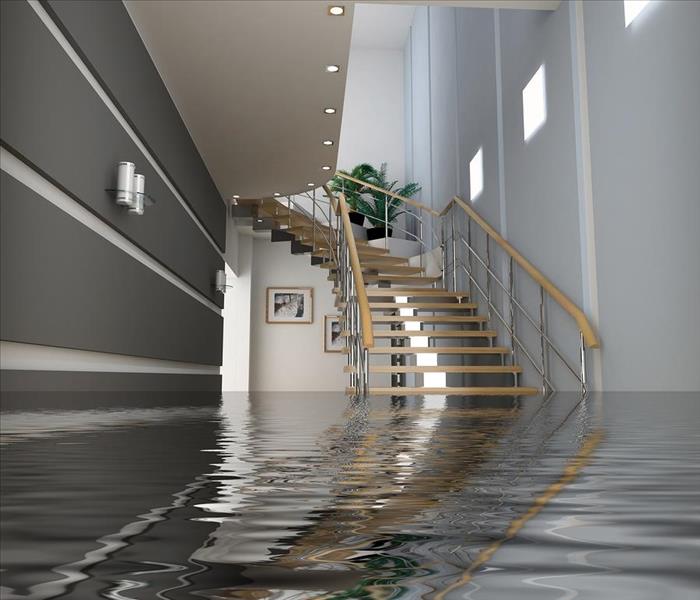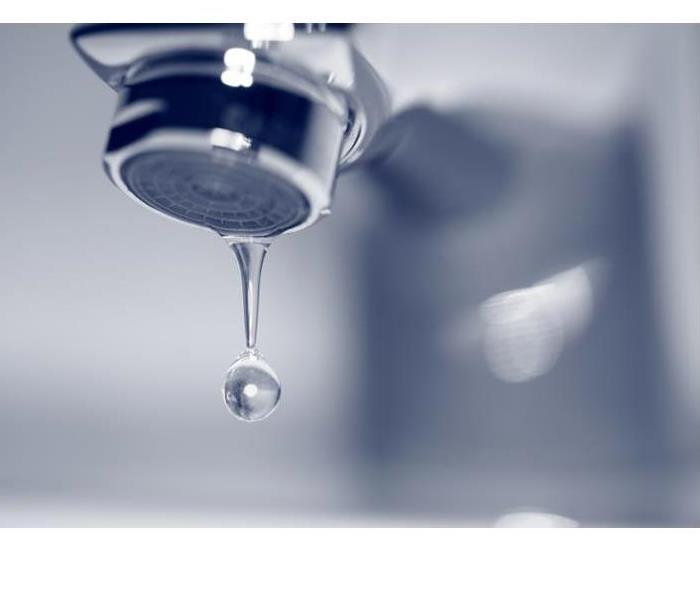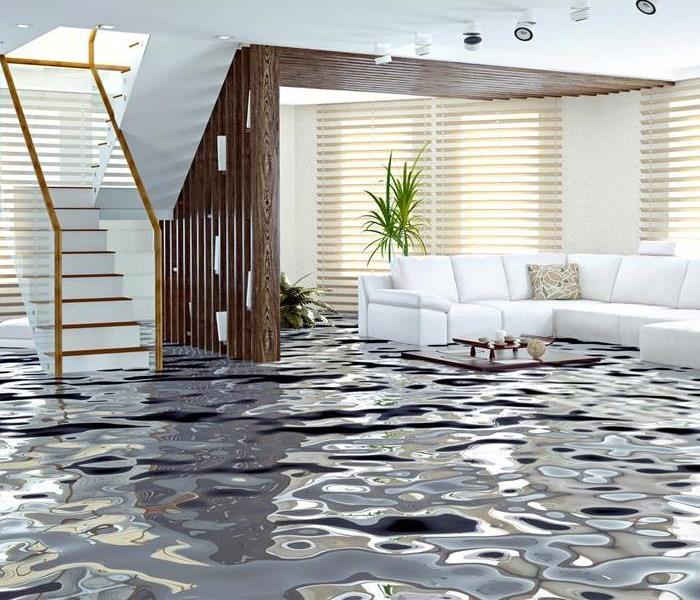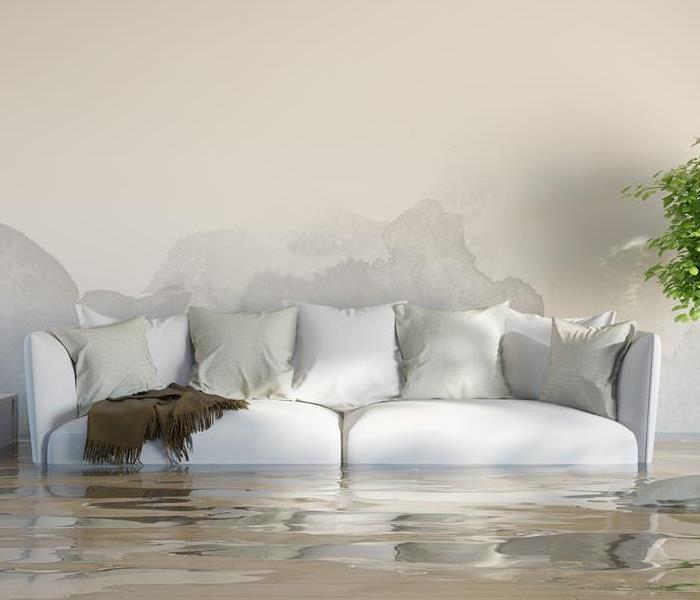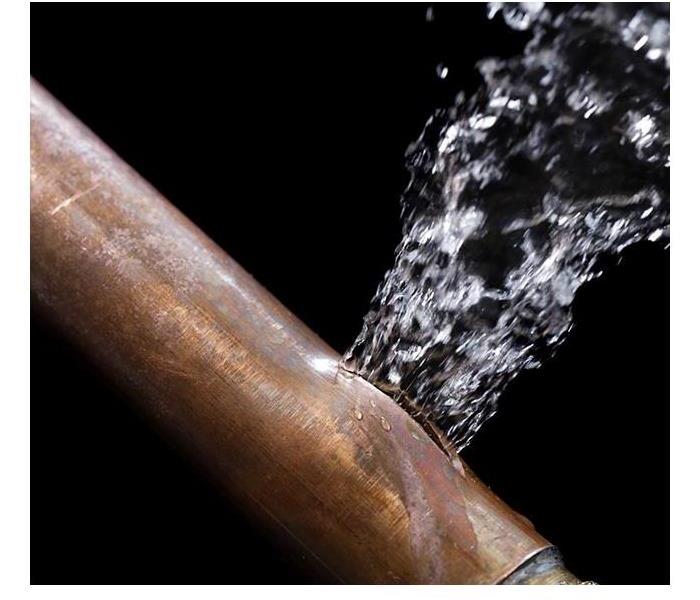Recent Water Damage Posts
Steps To Take When There Is Water Damage
7/17/2023 (Permalink)
There could be a point in your life that you encounter water damage in your home, but what are the steps that need to be taken if this were to happen before help arrives?
The first step is removing the source if it's possible. Is it a broke water pipe in your home? Turn off the water! Sometimes certain housing has to get their water turned off by another party.
The second step is worry about the electricity. The last thing we want anyone to be shocked by electricity. If the area that is wet has circuit breakers. Make sure to turn those off as well. It is important to note that no one should enter an area that may have affected electrical outlets, breakers, or equipment! It is not recommended that ceiling fans should not be turned on is the ceiling is wet!
The third step is, if possible, removing water that can be removed with a mop or towels. Do not use a vacuum!
The fourth step is removing propping furniture up it doesn't sit in the water and become damaged. This can be done putting the furniture on blocks or wrapping the legs of the furniture with aluminum foil. If the upholstery or cushions are soiled, move them to a well ventilated area to air dry. It isn't recommended that they are put into a dryer. All of the other belongings should be moved to an area that is dry. This includes electronics, artwork, clothing, documents, and anything else that is in the affected area.
Does Home Owner's Insurance Cover Water Damage?
2/20/2023 (Permalink)
DOES HOMEOWNER’S INSURANCE COVER WATER DAMAGE?
You already have insurance and you’re paying for it. But did you ever ask yourself if your homeowner’s insurance covers water damage? What’s covered and what’s not in your homeowner’s insurance policy?
Waking up to a flood due to faulty water heater is annoying especially after you realized your floor is damaged. Plumbing and leaking pipes can be a potential disaster, costing homeowners thousands of dollars. Water damage done to your home is covered by a standard homeowner’s insurance policy. However, not all types of water damage are covered. It’s not always easy to figure out when water damage is and isn’t covered by your policy because the distinctions are so fine, but this guide will inform you of the specific situations when your homeowner’s insurance will cover water damage.
When Does Homeowner’s Insurance Cover Water Damage?
Standard home insurance policies require water damage to be sudden and internal, with the requirement that the water has never touched the outside ground. It means that, if water damage occurs suddenly or accidentally from a source inside your home, such as a busted pipe, it will likely be covered by your homeowner’s insurance. If the water comes from outside your home, it will not be covered by your standard policy.
- Plumbing: Burst pipes, frozen plumbing, faulty plumbing, accidental overflow
- Water damage from extinguishing a fire
- A leaking roof (coverage would extend only to the home interior, not the roof itself)
- An accidental overflow of an appliance or fixture (toilet, washing machine, bathtub)
- Mold (only when it’s the result of covered water damage)
What types of water damage not covered by homeowner’s insurance?
Water damage is not covered by insurance if the result is not accident or unexpected occurrence. Here are three instances in which your homeowner’s policy will not provide coverage:
- Maintenance problems that have not been attended to
- Repair or replacement of the actual source of the water damage.
- Flooding
Standard policies won’t cover water damage resulting from a flood, you’ll need to purchase additional flood insurance, especially if you are in area prone to flooding.
If your house floods due to a burst pipe, which happened suddenly and accidentally, that would be an exception, your homeowner’s insurance can cover the costs of water damage.
Does homeowner’s insurance cover water damage from rain?
Homeowners insurance covers water damage from rain sometimes, but not always. It all depends on how the damage occurred. For example, if a storm opens a hole in your roof, allowing water to leak in and destroy valuable personal property, your policy typically offers coverage. But when lack of maintenance results in water damage, you won’t be covered.
If you do find yourself with water damage, call SERVPRO of Davenport/Bettendorf to help! 563-386-3540
Water Damage in My Home! What Should I Do?
9/22/2022 (Permalink)
A while ago we sent Jason and Ken to Living Local to educate them on what to do in the event of water damage in your home! Because it has been awhile, here is a refresher!
First and foremost, make sure you’re safe! Shut off circuit breakers for wet areas of your home, but only if access to the breaker panel is safe. Do NOT go into standing water where electrical shock hazards may exist.
Ken demonstrated in SERVPRO’s Living Local segment how to get the furniture off of wet carpets using wood blocks or aluminum foil. There is some misconception behind this tip – you may think it is to prevent damage to the furniture. It’s actually to prevent damage to the floor!
Our suggestion for separating your wooden furniture from the carpet is to prevent wood stains or fabric from staining your carpet. SERVPRO can dry furniture and carpet, but stained carpet poses a bigger challenge. For that reason, we also suggest you remove colored rugs and use wooden clothespins to keep furniture skirting off of your wet carpets to prevent staining. However, don’t try to move wet furniture from the area. When SERVPRO arrives to dry your space, our equipment will also dry the furniture in that space.
If you missed the great tips that Ken and Jason shared on SERVPRO’s Living Local segment, you can view them on our Youtube channel. https://youtu.be/1YQtQ1Vg42g
In the unfortunate event that you experience any kind of water loss, call SERVPRO of Davenport/Bettendorf Moline/Rock Island. We are available 24/7 to address your needs. The longer you wait to call, the greater chance of mold growth and unrepairable damage to your property may occur. Our team has the training and expertise to prevent or mitigate the effect of water damage.
Save Money on Plumbing with an Annual Plumbing Checklist!
8/16/2022 (Permalink)
If you own a home, you know how expensive plumbing work can be. That is why catching problems before they get out of hand can save you a lot of money each year. In this way, it is a good idea to check your plumbing at least once a year, as well as monitor any developing issues year-round. Below you will find a list of tips to keep your plumbing healthy and save you some cash.
Have a leaking showerhead?
This can lead to a large water bill. Always address any leaking faucets or pipes to save on water.
Have a slow drain?
It may seem like a minor inconvenience, but over time these can become major clogs and need professional intervention.
Low water pressure?
This may be due to mineral build-ups on showerheads or faucets. These can be cleaned with vinegar, or a light mineral deposit solution.
Toilet running?
You may need to fix the flapper or chain inside your toilet tank. Chains often get hung up on the flapper, so it may need adjustment.
Faster to your Davenport, Bettendorf, Clinton, or Muscatine Water Damage Event
7/1/2022 (Permalink)
Flooding and water emergencies don’t wait for regular business hours and neither do we. SERVPRO of Davenport/Bettendorf provides emergency cleaning and restoration services 24 hours a day, 7 days a week—including all holidays.
Faster To Any Size Disaster
Flooding and water damage is very invasive. Water quickly spreads throughout your home and gets absorbed into floors, walls, furniture, and more. SERVPRO of Davenport/Bettendorf arrives quickly and starts the water extraction process almost immediately. This immediate response helps to minimize the damage and the cleaning and restoration costs.
Need Emergency Service? Call Us 24/7 – (563) 386-3540
Water Damage Timeline
Within Minutes
- Water quickly spreads throughout your property, saturating everything in its path.
- Water is absorbed into walls, floors, upholstery, and belongings.
- Furniture finishes may bleed, causing permanent staining on carpets.
- Photographs, books, and other paper goods start to swell and warp.
Hours 1 - 24:
- Drywall begins to swell and break down.
- Metal surfaces begin to tarnish.
- Furniture begins to swell and crack.
- Dyes and inks from cloth and paper goods spread and stain.
- A musty odor appears.
48 Hours to 1 Week:
- Mold and mildew may grow and spread.
- Doors, windows, and studs swell and warp.
- Metal begins to rust and corrode.
- Furniture warps and shows signs of mold.
- Paint begins to blister.
- Wood flooring swells and warps.
- Serious biohazard contamination is possible.
More Than 1 Week:
- Restoration time and cost increase dramatically; replacing contaminated materials and structural rebuilding may be extensive.
- Structural safety, mold growth, and biohazard contaminants pose serious risks to occupants.
About SERVPRO of Davenport/Bettendorf
SERVPRO of Davenport/Bettendorf specializes in the cleanup and restoration of residential and commercial property after a fire, smoke or water damage event. Our staff is highly trained in property damage restoration. From initial and ongoing training at SERVPRO’s corporate training facility to regular IICRC-industry certification, rest assured our staff is equipped with the knowledge to restore your property.
TIME IS MONEY
7/1/2022 (Permalink)
The old adage is never more true than when dealing with a water-damaged home or business. Every minute matters, because every minute the property remains wet could turn primary damage into serious damage—or even permanent damage. That’s why emergency response matters.
Floods, broken pipes, and leaks don’t abide by the 9-to-5 workday. So why should your restoration provider? SERVPRO of Davenport/Bettendorf is on call 24 hours a day, 365 days a year with state-of-the-art equipment and proven methods to get the job done quickly and effectively.
If you find water creeping into your life, pick up the phone and call your local SERVPRO. Their highly trained professionals can help you avoid the cost and inconvenience of serious and permanent damage to your home and possessions. Call SERVPRO Davenport/Bettendorf at 563-386-3540—we’re faster to any size disaster.
What to Do Before Help Arrives: Water Damage
7/1/2022 (Permalink)
A pipe burst overnight. Or maybe a pipe has been leaking for a long time and you just now discovered it. What do you do now? First, you want to call a plumber depending on the severity of the leak. Next, call SERVPRO.
OK, SERVPRO is on the way; everything is going to be fine. But what do you do until we arrive? Here is a list of tips for what to do until help arrives during water damage:
- Get rid of any excess water with a mop or towel.
- Dry wood furniture to preserve the finish.
- Put aluminum foil between any wet carpet and furniture that you cannot move.
- Last but certainly not least, remove any lose items from rooms with wet flooring
Annual Maintenance Checklist: Plumbing
7/1/2022 (Permalink)
As the season's change and the weather gets warmer, it’s time to reevaluate the conditions of our homes and check each system to ensure proper functioning. Your plumbing system should be checked annually by either you or a professional plumber, depending on your expertise. The following tips will serve as a guide in your efforts to keep your plumbing system functioning properly and healthy.
- Check the p-traps—the U-shaped pipes—under your sinks to prevent clogs. If it has debris or a clog, remove the p-trap and clean it out with a nylon brush.
- Check all faucets and under your sinks for leaks or signs of leaks.
- Check your showerhead for leaks or mineral buildups. If your showerhead has excessive leaking or mineral deposits, it may need to be replaced, or at least be cleaned with a special solution.
- Check all visible piping throughout your house. Pipes with visible discoloration may have corrosion or other issues. Also check for mold or mildew, which can be a sign of small leaks. These should be inspected by a plumber and possibly replaced.
- Test your garbage disposal to ensure it is functioning properly.
- Make sure that your water heater is set to a safe and optimal temperature. Water temperature should be no higher than 120 degrees Fahrenheit, which is safe for use and will ensure a longer water heater lifespan.
If you have water damage from a leaking pipe or subsequent mold from water damage, call SERVPRO to make it “Like it never even happened.”
Water Everywhere!
7/1/2022 (Permalink)
Water and moisture can cause both structural and content damage when unnoticed. Even a small leak, left untreated, can lead to big loses.
Because mold growth can begin in less than 48 hours, water damage should be handled by trained professionals who have the equipment and knowledge to treat the situation, regardless of the size.
If you experience a water situation there are some things you can do until help arrives;
- Shut off the source of the water if possible or contact a qualified party to stop the water source.
- Turn off circuit breakers for wet areas when access to the power distribution panel is safe from shock.
- Remove as much water as possible by mopping and blotting.
- Wipe water from wood furniture and remove from the wet area, if possible, otherwise place aluminum foil between furniture legs and wet carpet.
- Remove from walls or wet areas all items that are valuable or sensitive to moisture - i.e. paintings, art objects, computers, documents, etc.
- Hang draperies with coated hangers to avoid contact with wet flooring.
If you have experienced water damage in recent months, call the professionals at SERVPRO Davenport/Bettendorf to access your situation and provide fast, effective clean up.
Flooded Basements
7/1/2022 (Permalink)
A basement can flood at any time, although flooding most often occurs during heavy rainfall. Basements are inherently prone to flooding because they are the lowest level of a building and are normally built partly or entirely below ground level. There are a number of reasons why your Davenport, Bettendorf, Muscatine or Clinton basement could flood, including:
- A blocked or failed sewer lateral pipe
- Heavy rain causes surface water to pool around your home
- Storm sewer backup
- Sanitary sewer backup
- Foundation drainage failure
- Water supply-line break or hot-water tank failure
- And many more
Have Questions about Basement Flooding?
Call Today - (563) 386-3540
If flood water is not handled quickly and properly, it can jeopardize your health and safety, and cause severe damage to your home’s structure. Remember, the longer you wait, the worse the problem will get.
The bottom line: a flooded basement can jeopardize your health, safety, and your home’s integrity. It’s worth making a call to SERVPRO of Davenport/Bettendorf and let our trained, professional crews handle the situation safely and correctly. We have earned the trust of hundreds of homeowners, business owners, and property professionals.
We are Flooded Basement Specialists:
- We are Available 24 hours/7 days per week
- We’re a Preferred Vendor to many National Insurance Companies
- We Bill The Insurance Directly – One Less Thing For You To Worry About
- Our Technicians are Highly-Trained in Water Restoration Techniques
- We use s500 IICRC Restoration Standards
- Advanced Inspection and Extraction Equipment
Basement Flooded? Call Us Today – We’re Ready To Help (563) 386-3540
SERVPRO's of The Quad Cities Water Damage Process
2/18/2022 (Permalink)
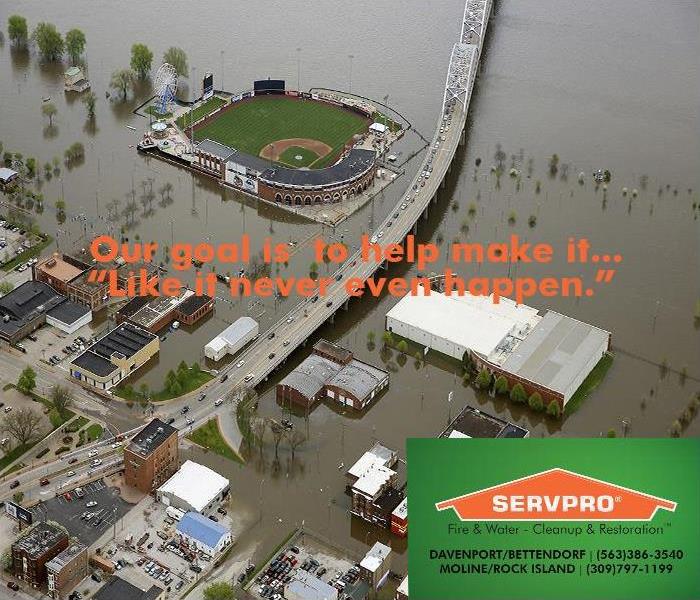 When there is water damage, CALL SERVPRO of the Quad Cities; we're here to help!
When there is water damage, CALL SERVPRO of the Quad Cities; we're here to help!
What is SERVPRO’s Water Damage Process?
In order to start our service and restoration service, you must sign the “Service Authorization Form.” That will allow us to take action immediately.
- 1 hour: from notice of loss SERVPRO professional will contact you to arrange for service
- 4 hours: of loss notification, we will be on-site to start mitigation service.
- Detailed Explanation: SERVPRO trained professional will walk you through the process, step-by-step
- Pretesting: a professional will begin pretesting for restorability
- 8 hours: of on-site arrival, a verbal briefing of the scope will be communicated to the appropriate person.
- Cleaning & Restoration: will work neatly and efficiently to help you regain control of your property when a damaging event has taken over. We use state-of-the-art restoration techniques to ensure your property is taken care of right the first time.
- Final walk-through: when the work is completed, we will have a final walk-through will be conducted to help ensure your satisfaction.
We also provide references upon request, if it helps and makes you feel more comfortable and confident in us!
So, when we get there, and we need to determine how to proceed; we have a few steps we do.
- Identify Source
- Identify the type of water
- Do a survey to see the extent of the damage and inspect the premises
- Identify signs of visible growth of mold
- We will move furniture; if needed
- Water Extraction
- Check the carpet pad
- Do our treatment for odor and disinfectant
- Disposal, we remove the bad
- Floor and Wall Inspection
- Inspect the carpet, remove it if needed
- Measure the temperature and humidity for drying analysis
- Use professional drying equipment
Thank you for choosing SERVPRO, we have over 50 years of experience and leadership in fire and water cleanup and restoration. Our goal is to help make it "Like it never even happened."
SERVPRO of Davenport/Bettendorf | (563)386-3540
SERVPRO of Moline/Rock Island | (309)797-1199
SERVPRO of Muscatine | (563)264-8661
Fun Facts About Water...DID YOU KNOW???
11/10/2021 (Permalink)
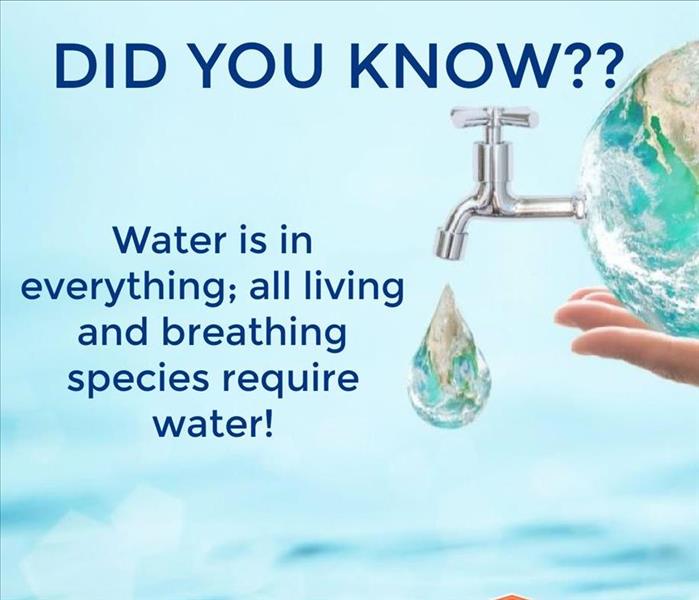 Everything Needs Water to survive!
Everything Needs Water to survive!
Did you know? Facts about Water:
Water! Water is essential to Earth's survival! Did you know that water is in everything…all living and breathing species require water and water is everywhere! Water mitigation and restoration are some of the pillars of our services, and so we thought we would list some interesting water facts.
- Many people can hear the difference between pouring hot versus cold water
- Less than 1% of the water supply on Earth can be used as drinking water
- A small drip leaking from a faucet is liable to waste as much as 34 gallons of water per day
- There are an estimated 240,000 water main breaks a year in the United States yearly
- The aging infrastructure in the US causes a water main break on average every 2 minutes
- Human bones are comprised of 31% water
- Every day, enough rain falls on the United States to cover the entire state of Vermont with over 2 feet of water
- Water can dissolve more substances than any other liquid, including sulfuric acid
- 6,800 gallons of water is required daily to grow enough food for a family of 4
Did you know that an acre of corn will give 4,000 gallons of water per day in evaporation! That’s crazy!
While water is beneficial to life, it can also cause wreak havoc on our lives and our surroundings. So when disaster strikes in the form of standing water, broken pipes, or flooding, don’t forget to call SERVPRO of the Quad Cities for all of your water mitigation emergencies. SERVPRO is your local Water Cleanup & Restoration Professionals! When disaster strikes, SERVPRO is here to help! 24/7
SERVPRO of Davenport/Bettendorf | (563)386-3540
SERVPRO of Moline/Rock Island | (309)797-1199
SERVPRO of Muscatine | (563)264-8661
Sump Pump Failure
9/14/2021 (Permalink)
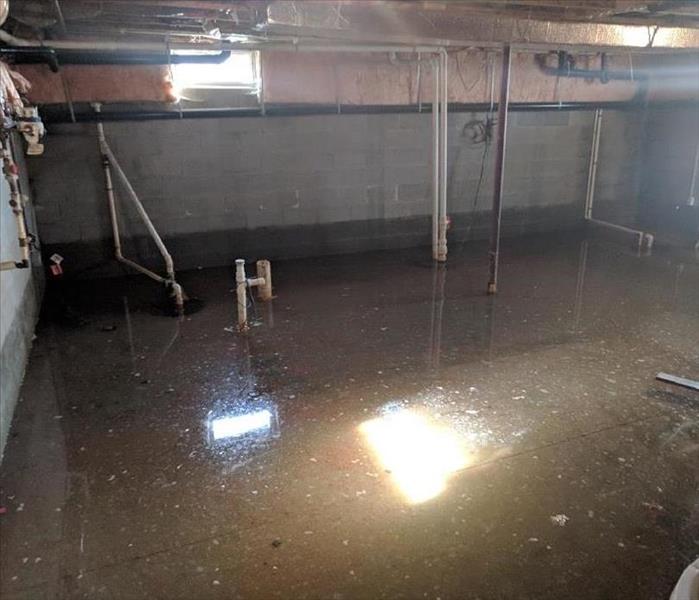 Always check your sump pump for issues. You do not want a flooded basement.
Always check your sump pump for issues. You do not want a flooded basement.
Sump Pump Failure
Why is my sump pump not working?: First, we should figure out what a sump pump is and what it is supposed to do. A sump pump is a pump that is used to remove water that has accumulated in the pump’s basin. You can usually find them in basements. If they fail; you’ll have standing water, which can cause mold, stench, and create damage to your home.
Have you ever wondered what causes sump pumps to fail? Here are a few reasons why:
Power Failure: without power, it’s completely worthless. You should have a battery backup in case of power failure.
Frozen Discharge Pipe: if that pipe is not attached correctly, water will gather and eventually freeze.
Switch Stuck in Place: there are several different types of sump float switches. Vertical and tethered are the most common. Verticals work best and tethered are known for getting stuck.
Overworked/Underpowered: not all pumps are the same. Make sure to install the correct horsepower to keep up with the flow of water.
Old Age: It is usually recommended that they be replaced every 5-7 years. Don’t wait until it's too late.
However, if your sump pump does fail and for whatever reason, it fails, SERVPRO of the Quad Cities is here to help. We off 24/7 full-service capabilities.
SERVPRO of Davenport/Bettendorf | (563)386-3540
SERVPRO of Moline/Rock Island | (309)797-1199
SERVPRO of Muscatine | (563)264-8661
Water Damage Restoration Process: 6 Steps
8/25/2021 (Permalink)
 It takes patience and time for things to dry out.
It takes patience and time for things to dry out.
Every flood and water damage situation is different, which means each one has a different solution that works best for its specific condition. Regardless of the situation, the water restoration process remains the same. Here is our 6-step process for a typical water-damaged property.
Step 1: Emergency Contact ~ the process begins the moment you call us! When you call, you should expect us to ask several questions regarding your emergency. These questions will help us determine what to bring.
Step 2: Inspection ~ we will do a detailed inspection of your home or property; which will include an assessment. We will check for the source of the water. Then we will determine the type of water. The type of water will affect the specific restoration process we use. We will then survey the damage. Also, we will move furniture and property contents to help prevent rust and stains, if needed.
Step 3: Water Removal ~ after the inspection and assessment, the water extraction begins. Our trained technicians will begin the water removal process. Then they will inspect the carpet and carpet pad; which may have to be removed, to protect the subfloor. The water removal equipment will detect moisture. We will use infrared cameras to see any hidden damage or water within the walls and ceiling.
Step 4: Drying ~ once all the water has been removed the drying process begins. We use dehumidification equipment, monitor it, and track its progress on all that was affected. Our drying equipment is to help prevent more damage.
Step 5: Cleaning ~ your walls, flooring, the ceiling will more likely require professional cleaning. We will do that along with cleaning your furniture, clothes, restorable belongings. We have the restore rather than replace mentality. We will also help get rid of any odor as well. We will also dispose of all damaged materials for you.
Step 6: Restoration ~ the process of restoring your home to pre-water damage condition! Restoration may include minor repairs.
SERVPRO can simplify the restoration process by handling both the initial water damage mitigation and rebuilding the affected areas. Having one qualified company for the entire process can save time and keep costs low.
SERVPRO of Davenport/Bettendorf | (563)386-3540
SERVPRO of Moline/Rock Island | (309)797-1199
SERVPRO of Muscatine | (563)264-8661
MOLD: It's more common than you know
6/30/2021 (Permalink)
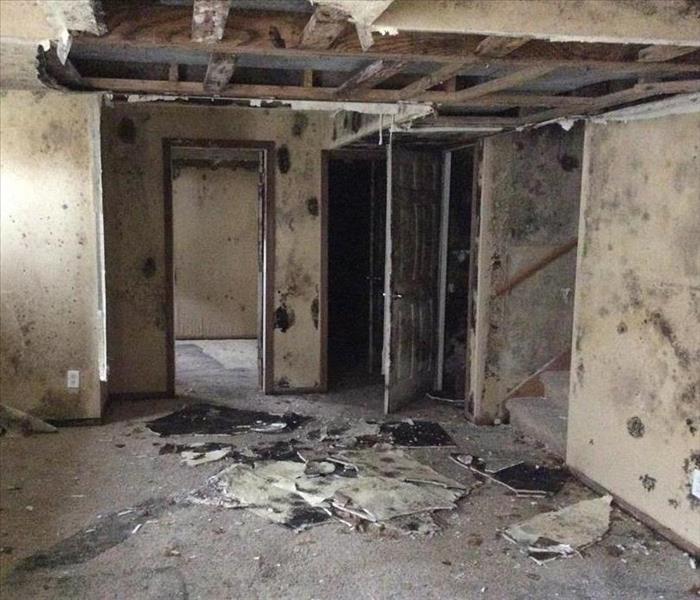 MOLD: So many types and is more common than you know. Mold in a basement...it can spread so fast.
MOLD: So many types and is more common than you know. Mold in a basement...it can spread so fast.
DID YOU KNOW THAT MOLD IS VERY COMMON?
Molds are common in homes and buildings. Mold will grow in places with a lot of moisture, leaky roofs, windows, pipes, or anywhere flooding has taken place. There are 12 different types of molds.
- Acremonium
- Toxigenic, which evolves over time. Acremonium mold is often pink, grey, orange, or white in color. Acremonium typically grows in household systems and areas such as condensation from humidifiers, cooling coils, drain pans, and window sealants.
- Alternaria
- A most common form of allergenic mold; typically grows where there is dampness (showers, bathtubs, and below leaky sinks. Most common species of mold that appears as a result of water damage
- It spreads quickly
- Aspergillus
- Common mold found in American households. There are over 185 species and in many different colors.
- It’s capable of becoming toxic.
- Aureobasidium
- An allergenic mold; can be found growing behind wallpaper or on painted wooden surfaces. It appears, pink, brown, or black usually.
- Chaetomium
- Commonly found in water-damaged homes and buildings; has a cotton-like texture and changes color over time.
- Chaetomium mold can grow in places such as your roof, basement foundation, or leaky pipes. Cutting off the moisture problem at the source will prevent this mold type from returning repeatedly.
- Cladosporium
- Can grow in both warm and cold places. It thrives in indoor materials such as carpets, fabrics
- Fusarium
- Growing and spreads in cold temperatures; toxic mold that can grow in homes with water damage and its usually pink-reddish color
- It will spread quickly.
- Mucor
- Allergenic mold grows in thick patches and is often white or greyish. Grows quickly.
- Penicillin
- It’s allergenic; easily recognizable because it's blue or green and has a velvet-like texture. Can be found in water-damaged buildings
- It’s helpful for antibiotic production and food processing. Their spores can easily become airborne.
- Stachybotrys
- KNOWN AS BLACK MOLD, toxic, loves damp, wet high humidity areas
- It’s greenish-black in color, known for growing on woods, cardboard, paper.
- Trichoderma
- The allergenic mold that appears in white and green patches and grows in homes on wet surfaces
- It actually has 5 different types. It thrives in moist areas, you can find it AC filters, HVAC system ducts.
- Ulocladium
- Loves wetness and water…like most molds. Usually black in color. Usually found in kitchens, bathrooms, basements, and around the windows.
All types of molds can be easily confused with another type. Calling a professional is always a good idea; if you suspect mold growing in your home or building. Stay healthy! We are a 24/7 company that offers full service. Our goal is to help make it…"Like it never even happened."
SERVPRO of Davenport/Bettendorf | (563)386-3540
SERVPRO of Moline/Rock Island | (309)797-1199
SERVPRO of Muscatine | (563)264-8661
Did you know, the category of water can affect the way the cleanup and restoration goes
6/30/2021 (Permalink)
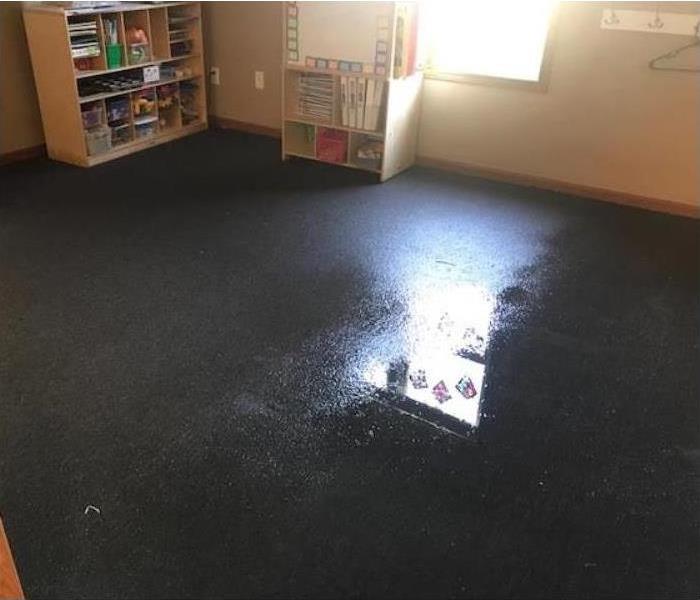 Water damage to carpet...
Water damage to carpet...
Identify the Type of Water
We will identify the category and classification of water damage to ensure our professionals restore your property based on industry guidelines. The level of contamination of the water will affect the specific restoration processes we use.
- Category 1: "Clean Water"
- Water that does not pose a threat to humans.
- Examples: broken water supply lines, tub or sink overflows.
- Category 2: "Gray Water"
- Water that is contaminated in some way, could cause discomfort or illness if ingested.
- Examples: toilet overflow with urine, dishwasher overflow, washing machine overflow
- Category 3: "Black Water"
- Water that is grossly contaminated with pollutants including fungi and bacteria.
- Examples: sewage, toilet backflows, flooding from seawaters, flooding from rivers and streams.
It depends on the type of water, which determines the proper course of action. Drying equipment controls temperature and humidity which will help minimize secondary damage.
If disaster strikes, know that you can count on SERVPRO. We are your #1 Fire & Water Cleanup & Restoration company. Our goal is to help make it…"Like it never even happened."
SERVPRO of Davenport/Bettendorf | (563)386-3540
SERVPRO of Moline/Rock Island | (309)797-1199
SERVPRO of Muscatine | (563)264-8661
Water and Electrical Don't Mix
6/28/2021 (Permalink)
 Safety first. Water and Electricity don't mix. Stay safe and follows these common tips
Safety first. Water and Electricity don't mix. Stay safe and follows these common tips
It’s that time of year, SUMMER! Do you want a pool or spa? Well besides being concerned about drowning, you need to think about the dangers of deadly shock. What is deadly shock? A severe medical condition. Here are some essential pool and spa electrical safety tips.
- Keep all outdoor receptacles covered and dry
- Make sure all equipment is grounded. It helps prevent electrocutions and electric shock
- All cords and devices should be at least 10 feet away from water
- You should try to use battery-operated appliances
- Make sure you do not touch any of the electrical pieces wet
- Make sure all power lines are not hovering over the pool or spa
- Do not swim during a thunderstorm, before or after
- An electrician should inspect and upgrade your pool or spa to avoid electric shock.
Remember any electrical devices pose a safety risk with water. SERVPRO is your # 1 trusted company in Fire & Water – Cleanup & Restoration. Our goal is to help make it…"Like it never even happened."
SERVPRO of Davenport/Bettendorf | (563)386-3540
SERVPRO of Moline/Rock Island | (309)797-1199
SERVPRO of Muscatine | (563)264-8661
Air Conditioners Can Cause Water Damage...HOW TO AVOID
6/9/2021 (Permalink)
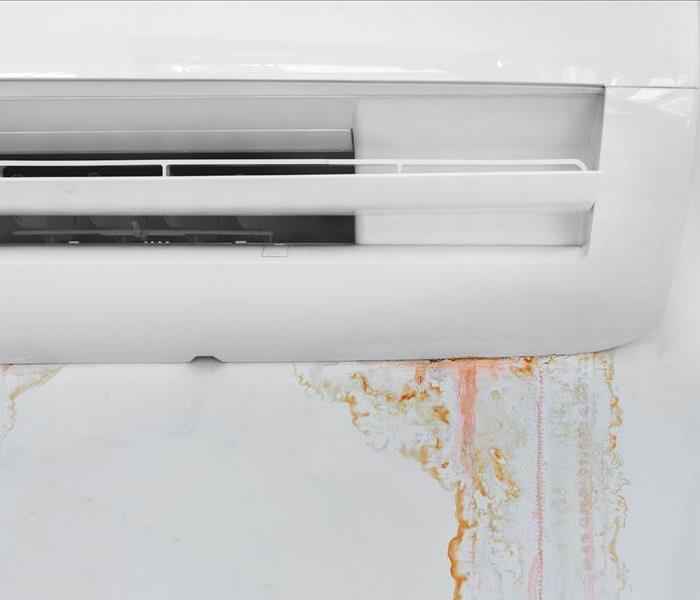 You can avoid your air conditioner leaking water.
You can avoid your air conditioner leaking water.
It’s that time of year again, temperatures rise, we shut the windows and turn on our air conditioners. Did you know that air conditioners can cause water damage?
Your HVAC may need some maintenance if you notice leaking or lingering smells. Water damage of any kind can create mold or a build-up of mold.
A few ways to help prevent water damage from your air conditioner:
Change your filter: that should be changed once a month
Keep it clean: they can collect dirt or leaves random objects. If not clean it won’t work properly, because it needs airflow to work properly
Keep Drain Line clear: make sure the water is flowing to the drain. Check lines, make sure drainage holes are clear
Install a pump: A condensation pump; will help extra water flow to drain.
No one wants to deal with water damage, and it can be annoying but more so costly if not taken care of properly. SERVPRO of the Quad Cities is here to help, we offer full-service capabilities with 24/7 services. We will respond quickly to assess the damage and will make it “Like it never even happened.”
SERVPRO of Davenport/Bettendorf | (563)386-3540
SERVPRO of Moline/Rock Island | (309)797-1199
SERVPRO of Muscatine | (563)264-8661
Living Local The Difference Professional Water Extracting Makes
5/24/2021 (Permalink)
 Our General Manager Jason Delzell with Living Local Host Mikhayla Hughes-Shaw
Our General Manager Jason Delzell with Living Local Host Mikhayla Hughes-Shaw
The Difference Professional Extracting Makes
With all of the rain that we are seeing in the Quad Cities these last couple of weeks, some of us may be experiencing water in our homes or basements. While it can be tempting to try and take care of the water damage yourself, it’s important to realize that a shop vacuum can leave a lot of moisture behind in your carpet pad! This week on Living Local, Jason and Dalton demonstrated the huge difference between professional water extraction and a shop vacuum.
Take a minute to watch the difference!
https://youtu.be/Ilbgd0TqCxY
Not only is it important to have professional equipment to remove water from your home or business. It’s important to have experts who know what they’re doing! Like Jason mentioned, all of our technicians at SERVPRO of the Quad Cities are professionally trained water technicians that are held to IICRC standards.
We hope these Spring showers are only helping your plants thrive, but should they be entering your home as well give us a call! We can make it “Like it never even happened.”
SERVPRO of Davenport/Bettendorf | (563)386-3540
SERVPRO of Moline/Rock Island | (309)797-1199
SERVPRO of Muscatine | (563)264-8661
Floor Drying System
4/27/2021 (Permalink)
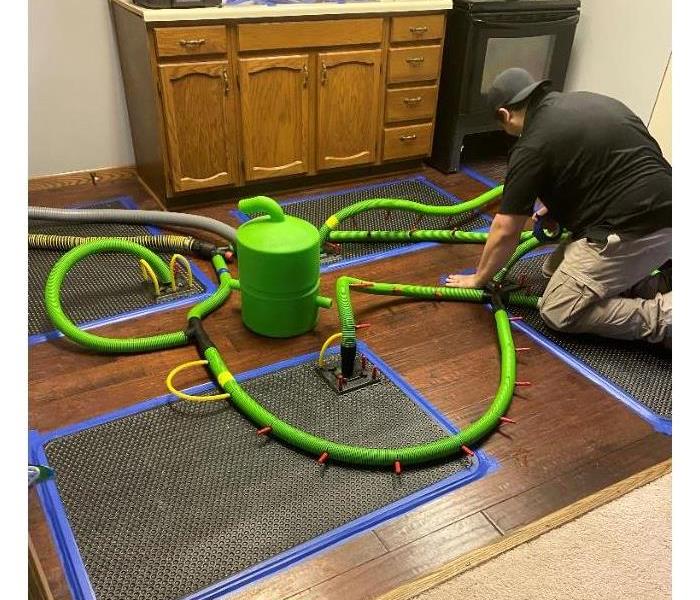 Our technicians are thoroughly trained to make water damage "Like it never even happened."
Our technicians are thoroughly trained to make water damage "Like it never even happened."
We all know that water and hardwood floors should not mix, which can be devastating when you experience a water loss. It does not have to be though – SERVPRO has a floor drying system that when implemented quickly can save your wood flooring!
We have trained our technicians on how to restore even the most dramatic water losses. The floors in this photo were used for training – we let a hose completely saturate them and sit for 24 hours. After placing panels with an airtight seal on the floors, our crew suctioned all of the water between the subfloor and hardwood floors and between all of the grooves. All of the water in the floors was removed and dehumidifiers were placed to remove any additional moisture.
Do not assume that your wood floors need to be replaced if you have a water loss. Thanks to our intense training, thorough techniques, and professional equipment – homeowners can have peace of mind when they experience a water loss. SERVPRO has a great track record in making water damage seem “Like it never even happened."
Thawing Snow & Ice
2/19/2021 (Permalink)
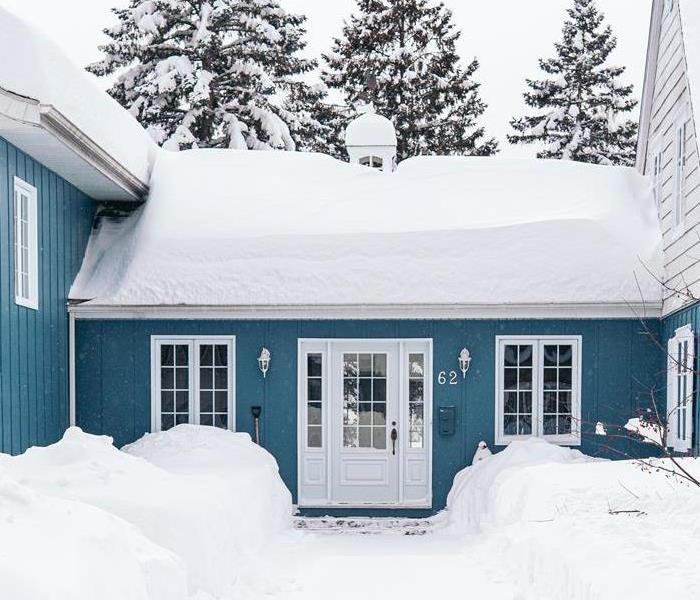
Freezing temperatures have brought their fill of water damage to Quad Cities homeowners through burst pipes and ice dams. Though temperatures are rising in the coming weeks, there are still many ways that water damage can affect your home. It’s important to be proactive about preventing thawing ice and snow from getting into your home through your roof or foundation. One key way to avoid water infiltrating your home is to move snow off of your roof and away from your foundation. Ensure your windows and doors are appropriately sealed and consistently check your pipes to make sure there is no cracking and check your basement for any leaks. Not only can this melting snow and ice cause structural damage and loss of personal items, but mold can develop within 24-48 hours of water exposure and will continue to spread until water damage is mitigated. If you do have any water coming into your home, contact SERVPRO as soon as possible. We will dry your home, check for and remove mold, and we can even restore damaged documents and personal items.
SERVPRO of Davenport/Bettendorf | (563)386-3540
SERVPRO of Moline/Rock Island | (309)797-1199
SERVPRO of Muscatine | (563)264-8661
Water in Basement? Use a Submersible Pump
7/6/2020 (Permalink)
With all the rain we are experiencing in the Quad Cities this time of year, many of us are getting some water in our basements. This can be a huge pain, especially when the standing water lingers around for days. And, in addition to causing a mess, the standing water can also cause lasting and costly damage. This makes a submersible pump an asset.
Whether your existing sump pump stops working or is overwhelming by more ground water than normal, having an extra submersible pump handy can be a huge help. Even if your sump pump is working fine, it is always a good idea to have an extra for support during heavy rains.
With water damage, time is money. So the faster you get it out, the more money you will save. So get a submersible pump and be prepared.
What to Do Before Help Arrives: Water Damage
6/30/2020 (Permalink)
A pipe burst overnight. Or maybe a pipe has been leaking for a long time and you just now discovered it. What do you do now? First, you want to call a plumber depending on the severity of the leak. Next, call SERVPRO.
OK, SERVPRO is on the way; everything is going to be fine. But what do you do until we arrive? Here is a list of tips for what to do until help arrives during a water damage:
- Get rid of any excess water with a mop or towel.
- Dry wood furniture to preserve the finish.
- Put aluminum foil between any wet carpet and furniture that you cannot move.
- Last but certainly not least, remove any lose items from rooms with wet flooring.
Save Money on Plumbing with an Annual Plumbing Checklist
6/30/2020 (Permalink)
If you own a home, you know how expensive plumbing work can be. That is why catching problems before they get out of hand can save you a lot of money each year. In this way, it is a good idea to check your plumbing at least once a year, as well as monitor any developing issues year-round. Below you will find a list of tips to keep your plumbing healthy and save you some cash.
Have a leaking showerhead?
This can lead to a large water bill. Always address any leaking faucets or pipes to save on water.
Have a slow drain?
It may seem like a minor inconvenience, but over time these can become major clogs and need professional intervention.
Low water pressure?
This may be due to mineral build-ups on showerheads or faucets. These can be cleaned with vinegar, or a light mineral deposit solution.
Toilet running?
You may need to fix the flapper or chain inside your toilet tank. Chains often get hung up on the flapper, so it may need adjustment.
SERVPRO is Here for Your Quad Cities Water Damage
6/5/2020 (Permalink)
SERVPRO of Davenport/Bettendorf and Moline/Rock Island is a locally owned and operated business, so we are part of this community, too. When you have a flooding or water damage emergency, we’re already nearby and ready to help, right here in the Quad Cities.
If your Quad Cities home or business has been damaged by water due to flooding or water leaks, SERVPRO is “Here to Help” 24 hours a day, 7 days a week. That’s right, we are always available. With over 25 years of dedication to our Quad Cities customers, we have the experience, expertise, and equipment necessary to restore your property back to preloss condition. With our state-of-the-art drying technology, our water removal and cleanup process provides validation and documentation, which confirms that your property is dry. And our highly trained water restoration specialists arrive quickly to your property to avoid further damage and save you money.
Have Water or Flood Damage? Call Us Today (563) 386-3540
SERVPRO Water Damage Process
6/4/2020 (Permalink)
Water damage can be frustrating; but SERVPRO can make it “Like it never even happened.” And the process starts from the moment we receive your call. Here is a break done of the steps in the SERVPRO water damage process:
The first step is giving us a call in your time of need. One of our trained representatives will advise you through your crisis. We may have some questions for you to provide the best game plan for your water damage.
Next, we will come to you to inspect and test your property. This will help us better determine the extent of damage, as well as gauge how far the moisture has traveled.
Then the fun part: water extraction. We begin removing the water almost immediately using powerful pumps and vacuum units. Removing the water fast is important to avoid mold growth.
We will then use specialized equipment to remove any remaining water. It is not always easy to tell if moisture still remains; that is where SERVPRO’s advanced technology comes into play.
Once your property is dry, it is time for cleaning and sanitizing. SERVPRO has its own line of propriety and safe chemicals that will get your home or business perfectly clean.
Then, SERVPRO will restore anything that was not salvageable by the water damage, making it truly “Like it never even happened.”
What to Do During a Water Damage
5/20/2020 (Permalink)
When you had a leaking or burst pipe, what’s the first thing you do? Call SERVPRO. OK, everything will be alright. But what do you do until help arrives? First, your safety is most important, so ask yourself: is it safe to stay in the house; are electrical outlets exposed to water; is it possible you could slip and fall? If the answer is no, it is OK to proceed.
During a water damage, acting fast is crucial. And there are several things you can be doing before SERVPRO arrives to lessen the ultimate damage. Here are some tips to avoid larger damage in the event of water issues:
- Try to remove any excess water by mopping or blotting
- Wipe excess water off wood furniture to preserve finish
- Place aluminum foil or blocks between furniture and wet carpet
- Remove any lose items from wet flooring
Flood of 2019
6/18/2019 (Permalink)
The flood of 2019 has been the worst flood in the Quad Cities in recorded history. We have broken several records, including flood depth, amount of time at flood stage, and record rainfall days in May. While we have grown accustomed to flooding over the years, and have procedures in place to combat water damage to businesses and residences, this flood overwhelmed many of our safeguards.
One of those safeguards is the HESCO barrier. When the barrier collapsed due to prolonged water pressure and increased height, businesses were caught off guard. Many lost a large portion of their merchandise. Others have had to remain closed and even vowed to move their business location permanently.
However, as the water goes down, both our residents and our businesses are starting to rebuild. Home owners are having their basements cleaned out and businesses are starting to once again stock their shelves in anticipation of reopening. The Quad Cities have once again pulled through during a brutal flood season and now look toward the future!
Annual Maintenance Checklist: Plumbing
5/21/2019 (Permalink)
 The p-trap is the U-shaped pipe under your sink. Make sure to check these frequently, as they can become clogged and cause drain back-ups.
The p-trap is the U-shaped pipe under your sink. Make sure to check these frequently, as they can become clogged and cause drain back-ups.
As the seasons change and the weather gets warmer, it’s time to reevaluate the conditions of our homes and check each system to ensure proper functioning. Your plumbing system should be checked annually by either you or a professional plumber, depending on your expertise. The following tips will serve as a guide in your efforts to keep your plumbing system functioning properly and healthy.
- Check the p-traps—the U-shaped pipes—under your sinks to prevent clogs. If it has debris or a clog, remove the p-trap and clean it out with a nylon brush.
- Check all faucets and under your sinks for leaks or signs of leaks.
- Check your showerhead for leaks or mineral buildups. If your showerhead has excessive leaking or mineral deposits, it may need to be replaced, or at least be cleaned with a special solution.
- Check all visible piping throughout your house. Pipes with visible discoloration may have corrosion or other issues. Also check for mold or mildew, which can be a sign of small leaks. These should be inspected by a plumber and possibly replaced.
- Test your garbage disposal to ensure it is functioning properly.
- Make sure that your water heater is set to a safe and optimal temperature. Water temperature should be no higher than 120 degrees Fahrenheit, which is safe for use and will ensure a longer water heater lifespan.
If you have water damage from a leaking pipe, or subsequent mold from water damage, call SERVPRO to make it “Like it never even happened.”
How To Use A Submersible Pump
5/8/2019 (Permalink)
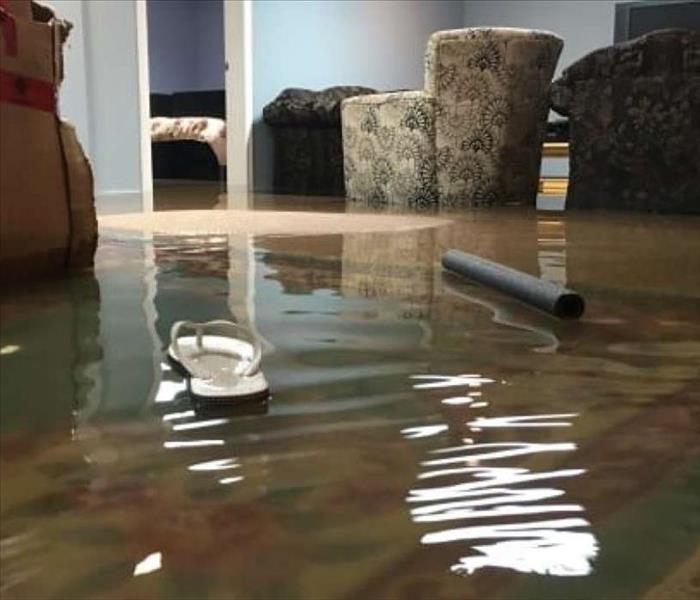 A submersible pump can keep rising water at bay and reduce the amount of damage to your home.
A submersible pump can keep rising water at bay and reduce the amount of damage to your home.
As we experience heavy rains here in the Quad Cities, SERVPRO receives an overflow of calls regarding water in basements. This may be due to seepage through the floor or foundation of your basement, or possibly a failed sump pump. Whatever the cause, water in your basement can lead to extensive water damage to your home and belongings, especially if you have a finished basement. For this reason, a submersible pump is a great product to keep on hand to slow the rising of water in your basement as it comes in, which will reduce the scope of damage, and to remove the remaining water once the rain or flooding has stopped. Once you have your submersible pump, it is important to follow a number of steps to ensure proper water removal. Below are tips on how to set up your pump:
- Along with your pump you will need a hose. This is sometimes a simple garden hose, sump hose, or possibly one that comes with your pump. You will want to make sure you have a long enough hose to get from your pump to your drainage site.
- Next you will need to connect the hose to your pump. Make sure that the connection is secure before starting your pump. Also consider that if the water you are removing is contaminated your hose may no longer be safe for other uses.
- You will then be ready to plug and your pump and start removing the water from your basement. Be sure to submerge your pump in the deepest water within your home. This will help you avoid running the pump dry. It will also allow your pump to keep working until a majority of the water is removed, as some pumps have floats that will automatically shut the power off once the water has reached a certain level.
- Keep an eye on your pump to make sure it is working properly. Also make sure that the area is free of debris to avoid clogs.
If you have water in your basement, call SERVPRO at 563-386-3540 to make it “Like it never even happened.”
Understanding Different Water Types
4/30/2019 (Permalink)
When your home or business suffers from a water damage, it is important to understand the type of water present to ensure proper clean-up. This is because there are 3 types, or categories, of water, each having its own safety distinction. Water is considered “clean”, or a category 1, when it comes from a broken pipe or rain. If you suffer a water damage from clean water, make sure to do the following things until help arrives:
- Shut off your home or business water source, if possible.
- Turn off circuit breakers for wet areas. However, only do this if it is safe, and do not enter rooms with standing water to avoid electric shock.
- Once safe, try to clean up as much water as possible from floors and wipe down wood furniture.
Another water type is “gray water”, or category 2. Clean water can become gray water when it is left untreated, allowing bacteria and other contaminates to grow freely. This type of water is considered contaminated and hazardous. The 3rd water type is “black water”, or category 3, which is highly contaminated and filled with bacteria, fungi, chemicals, and more. This type of water is typically caused by sewage back up, flooding, or other types of natural disaster. Black water should be avoided and only handled by trained professionals. If you suffer a water damage from contaminated water, category 2 or 3, do the following things until help arrives:
- Avoid making contact with gray or black water. Make sure to wash hands thoroughly after coming into contact with contaminated items.
- Do not walk through areas contaminated by gray or black water, as you may spread damage to other unaffected areas.
- Do not turn on HVAC system to avoid spreading contaminated air.
- Do not use household fans to dry contaminated water damage.
- Do not keep any food that comes into contact with contaminated water.
For more information about water types, please contact your SERVPRO of Davenport/Bettendorf water damage professionals at 563-386-3540.
Steps to Help Prevent Frozen Pipes
1/25/2019 (Permalink)
1/25/2019
You wake up on a cold winter morning, head into the bathroom or kitchen, turn the faucet and … a trickle. Or, nothing at all.
You have a frozen pipe. What do you do now? Better yet, how do you avoid this messy, potentially expensive situation in the first place?
Here are some ideas to help keep the water flowing inside, even as the freeze sets in outside:
Before It Gets Cold
- Drain water supply lines to your sprinkler and swimming pool. Don't put antifreeze in the lines; spills or leaks can threaten pets, wildlife and landscaping.
- Disconnect and drain outdoor hoses before putting them in storage. Place an inexpensive foam cover over the faucet. Better yet, close the inside valves that supply water to the hose bibs. Then open the outside hose bibs to let any remaining water drain out, and leave them open.
- Insulate water pipes with pipe sleeves, heat tape or heat cable, particularly pipes that run through unheated areas of the house, such as attics, basements, crawl spaces and garages.
As Temperatures Drop
- Keep your house warm, and allow the warm air to circulate as much as possible. Seal drafts and keep interior doors open. If you’re going to be gone for an extended period, don’t turn off the heat. Keep it set to at least 55 degrees Fahrenheit.
- Open cabinet doors under kitchen and bathroom sinks to allow heat to reach the pipes. Be sure to move cleaners and other chemicals out of reach of children and pets.
- Open indoor faucets, hot and cold, to allow a trickle of water. Flowing water is less likely to freeze.
When a Pipe Freezes
- The first thing to do, faced with the telltale trickle, is try to find where the pipe is frozen. Keep the faucet open, and open other faucets in the house to determine if the problem is widespread. If it is, turn off the main water supply and call a plumber.
- If it's a single pipe, and you can reach the frozen section, try using a hair dryer, heating pad or portable space heater – just never leave it running unattended. Keep the faucet open and work up and down the pipe, starting at the faucet and working backward to the frozen section. Apply heat until full water pressure returns, then reduce the flow to a trickle until the cold snap ends.
- An alternative method: Wrap the frozen section with towels soaked in hot water. Don't pour hot water directly on a frozen pipe, and don't use a propane torch or other open flame.
If these approaches don't work, or if you have a leaking or burst pipe, don't hesitate to turn off the main water supply and call in a licensed plumber. And, be sure to touch base with your insurance agent, too, preferably before a crisis. You'll want to know whether you're covered for burst pipes and the ensuing water damage
Water, Water, Everywhere
1/25/2019 (Permalink)
1/25/2019
Water and moisture can cause both structural and content damage when unnoticed. Even a small leak, left untreated, can lead to big loses.
Because mold growth can begin in less than 48 hours, water damage should be handled by trained professionals who have the equipment and knowledge to treat the situation, regardless of the size.
If you experience a water situation there are some things you can do until help arrives;
- Shut off the source of the water if possible or contact a qualified party to stop the water source.
- Turn off circuit breakers for wet areas when access to the power distribution panel is safe from shock.
- Remove as much water as possible by mopping and blotting.
- Wipe water from wood furniture and remove from the wet area, if possible, otherwise place aluminum foil between furniture legs and wet carpet.
- Remove from walls or wet areas all items that are valuable or sensitive to moisture - i.e. paintings, art objects, computers, documents, etc.
- Hang draperies with coated hangers to avoid contact with wet flooring.
If you have experienced water damage in recent months, call the professionals at SERVPRO Davenport/Bettendorf to access your situation and provide fast, effective clean up.
What you need to know about flooded basements
6/6/2018 (Permalink)
A basement can flood at any time, although flooding most often occurs during heavy rainfall. Basements are inherently prone to flooding because they are the lowest level of a building and are normally built partly or entirely below ground level. There are a number of reasons why your Davenport, Bettendorf, Muscatine or Clinton basement could flood, including:
- A blocked or failed sewer lateral pipe
- Heavy rain causes surface water to pool around your home
- Storm sewer backup
- Sanitary sewer backup
- Foundation drainage failure
- Water supply-line break or hot-water tank failure
- And many more
Have Questions about Basement Flooding?
Call Today - (563) 386-3540
If flood water is not handled quickly and properly, it can jeopardize your health and safety, and cause severe damage to your home’s structure. Remember, the longer you wait, the worse the problem will get.
The bottom line: a flooded basement can jeopardize your health, safety, and your home’s integrity. It’s worth making a call to SERVPRO of Davenport/Bettendorf and let our trained, professional crews handle the situation safely and correctly. We have earned the trust of hundreds of homeowners, business owners, and property professionals.
We are Flooded Basement Specialists:
- We are Available 24 hours/7 days per week
- We’re a Preferred Vendor to many National Insurance Companies
- We Bill The Insurance Directly – One Less Thing For You To Worry About
- Our Technicians are Highly-Trained in Water Restoration Techniques
- We use s500 IICRC Restoration Standards
- Advanced Inspection and Extraction Equipment
Basement Flooded? Call Us Today – We’re Ready To Help (563) 386-3540
Do’s and Don’ts of drying out clean water in home or business
5/1/2018 (Permalink)
The following are a few helpful tips on action you or your family can follow until SERVPRO of Davenport/Bettendorf arrives:
DO
- Remove as much excess water as possible by mopping and blotting.
- Wipe excess water from wood furniture after removal of lamps and tabletop items.
- Place aluminum foil or wood blocks between furniture legs and wet carpeting.
- Turn air conditioning on for maximum drying in summer.
- Remove oriental rugs or other colored rugs from wet wall-to-wall carpeting or hardwood floors.
- Open and place luggage in sunlight to dry, if possible.
DON’T
- Leave wet fabrics in place; dry as soon as possible.
- Leave books, magazines or other colored items on wet carpets or floors.
- Use TV’s or other household appliances while standing on wet carpets or floors, especially not on wet concrete floors.
Take the proper precautions when dealing with water damage. Even small water damages have the potential to cause serious structural and indoor air quality issues over time. Your local SERVPRO professionals have the training and equipment to help make it, “Like it never even happened.” Call us at (563) 386-3540.
Who to call for a water damage
4/11/2018 (Permalink)
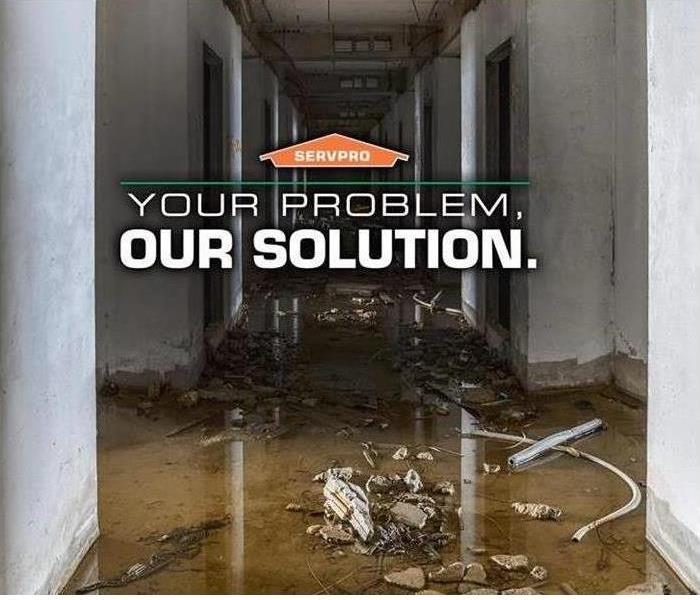 Our highly trained crews are ready to respond 24/7 to storm or flood damage in the Quad Cities and surrounding areas.
Our highly trained crews are ready to respond 24/7 to storm or flood damage in the Quad Cities and surrounding areas.
SERVPRO of Davenport/Bettendorf specializes in storm and flood damage restoration. Our crews are highly trained and we use specialized equipment to restore your property to its pre-storm condition.
Faster Response
Since we are locally owned and operated, we are able to respond quicker with the right resources, which is extremely important. A fast response lessens the damage, limits further damage, and reduces the restoration cost.
Resources to Handle Floods and Storms
Whether storms hit Davenport, Bettendorf, Muscatine, or Clinton, we can scale our resources to handle a large storm or flooding disaster. We can access equipment and personnel from a network of 1,650 Franchises across the country and elite Disaster Recovery Teams that are strategically located throughout the United States.
Have Storm or Flood Damage? Call Us Today 563-386-3540
How to manage damage from clean water or damage from contaminated water
1/5/2018 (Permalink)
Damage from clean water
- Shut off the water source if possible or contact a qualified professional to do so
- Turn off circuit breakers from wet areas of the building if access to the power distribution panel is safe from potential electrical shock. Do not enter rooms with standing water, as electrical shock hazards may exist.
- Remove as much excess water as possible by mopping and blotting. Wipe excess water from wood furniture after removing lamps and tabletop items.
- Remove and prop up wet upholstery cushions to allow more even drying.
- Move any paintings, art objects, computers, documents and other valuable items that may be sensitive to moisture to a safe place.
- Do not leave books, newspapers, magazines or other colored items on wet carpets or floors as they may cause staining.
- Do not use your household vacuum cleaner to remove water as there is potential for electrical shock or causing damage to the vacuum cleaner.
- Do not turn on ceiling fixtures if ceiling is wet; do not enter rooms where ceilings are sagging from retained water.
Damage from contaminated water
- Avoid all contact with sewage and items contaminated by sewage. Wash your hands thoroughly if you come in contact with contaminated items.
- Do not walk through contaminated areas, as you could spread damage to unaffected areas.
- Do not turn on the HVAC system if there is a possibility of spreading contaminated air.
- Do not use household fans to dry the structure; air flow could spread contaminants.
- Discard any food and/or products for personal hygiene and cleanliness if exposed to the contaminated areas.
When you have a water damage, don’t leave your property to chance. Call SERVPRO Davenport/Bettendorf at (563) 386-3540.
Water, water everywhere
12/7/2017 (Permalink)
Water and moisture can cause both structural and content damage when unnoticed. Even a small leak, left untreated, can lead to big loses.
Because mold growth can begin in less than 48 hours, water damage should be handled by trained professionals who have the equipment and knowledge to treat the situation, regardless of the size.
If you experience a water situation there are some things you can do until help arrives;
- Shut off the source of the water if possible or contact a qualified party to stop the water source.
- Turn off circuit breakers for wet areas when access to the power distribution panel is safe from shock.
- Remove as much water as possible by mopping and blotting.
- Wipe water from wood furniture and remove from the wet area, if possible, otherwise place aluminum foil between furniture legs and wet carpet.
- Remove from walls are wet area all items that are valuable or sensitive to moisture. e. – Paintings, art objects, computers, documents, etc.
- Hang draperies with coated hangers to avoid contact with wet flooring.
If you have experienced water damage in recent months, call the professionals at SERVPRO Davenport/Bettendorf to access your situation and provide fast, effective clean up.
You Can Protect Your Property with Water Preventative Tools
12/7/2017 (Permalink)
Undetected water can cause a great deal of damage to a building structure and contents. To prevent this type of disaster a home or business owner can install water detection systems. Water leak detection systems help identify leaks which, in some circumstances, can help prevent a flood. Water monitoring systems are generally activated at the first sign of excess moisture or seepage resulting from a leak.
Water Alarms: Water alarms also known as leak sensors are typically battery-operated stand-alone systems contacting a moisture sensor that will activate an audible alarm when moisture is detected. Benefits of water alarms are accessibility and price. They are fairly inexpensive and easy to install.
Water Systems: While most water alarms simply notify you of a leak, water systems will actually shot off the water supply causing water damage. The downside to water systems is that they only apply to water caused by an appliance or water supply and do not cover water that occurs from rain, broken pipes or or sump pump failure.
Leak Prevention Tips
Regularly check the following items for leaks:
- Check roofing for deterioration.
- Check gutters and downspouts for blockage.
- Check basements and crawl space for moisture.
- Check under and around appliances.
- Check sinks and toilets.
- Check HVAC for leaks and blockage.
If you suspect you have suffered a water damage—past or present, call SERVPRO Davenport/Bettendorf for fast, courteous and knowledgeable service. 563-386-3540
TIME IS MONEY
12/7/2017 (Permalink)
The old adage is never more true than when dealing with a water-damaged home or business. Every minute matters, because every minute the property remains wet could turn primary damage into serious damage—or even permanent damage. That’s why emergency response matters.
Floods, broken pipes and leaks don’t abide by the 9-to-5 workday. So why should your restoration provider? SERVPRO of Davenport/Bettendorf is on call 24 hours a day, 365 days a year with state of the art equipment and proven methods to get the job done quickly and effectively.
If you find water creeping into your life, pick up the phone and call your local SERVPRO. Their highly trained professionals can help you avoid the cost and inconvenience of serious and permanent damage to your home and possessions. Call SERVPRO Davenport/Bettendorf at 563-386-3540—we’re faster to any size disaster.
If Your Home's Sump Pump Fails, SERVPRO of Davenport/Bettendorf Can Help!
6/21/2017 (Permalink)
Sump pumps are a very important feature to any home. Without getting technical, and to make a long story short, Sump Pumps keep your basement dry. When heavy rains hit, the pump kicks in and take water away from your home. It is extremely important to discuss your pump's coverage with your insurance agent, because sometimes these pumps can fail and cause damage to your home.
A power outage, from a storm for instance, can cause your pump to fail which could result in a flooded basement. SERVPRO of Davenport/Bettendorf have seen too many sump pump failures to count. We can't service your pump, but we can help clean up when a pump malfunction damages your basement.
If your Davenport, Bettendorf, Muscatine or Clinton home has a flooded basement due to sump pump failure call SERVPRO of Davenport/Bettendorf at (563) 386-3540.
Faster to your Davenport, Bettendorf, Clinton, or Muscatine Water Damage Event
12/9/2016 (Permalink)
 SERVPRO of Davenport/ Bettendorf provides 24 hour fire and water damage restoration service in Davenport, Bettendorf, Clinton and Muscatine.
SERVPRO of Davenport/ Bettendorf provides 24 hour fire and water damage restoration service in Davenport, Bettendorf, Clinton and Muscatine.
Flooding and water emergencies don’t wait for regular business hours and neither do we. SERVPRO of Davenport/Bettendorf provides emergency cleaning and restoration services 24 hours a day, 7 days a week—including all holidays.
Faster To Any Size Disaster
Flooding and water damage is very invasive. Water quickly spreads throughout your home and gets absorbed into floors, walls, furniture, and more. SERVPRO of Davenport/Bettendorf arrives quickly and starts the water extraction process almost immediately. This immediate response helps to minimize the damage and the cleaning and restoration costs.
Need Emergency Service? Call Us 24/7 – (563) 386-3540
Water Damage Timeline
Within Minutes
- Water quickly spreads throughout your property, saturating everything in its path.
- Water is absorbed into walls, floors, upholstery, and belongings.
- Furniture finishes may bleed, causing permanent staining on carpets.
- Photographs, books, and other paper goods start to swell and warp.
Hours 1 - 24:
- Drywall begins to swell and break down.
- Metal surfaces begin to tarnish.
- Furniture begins to swell and crack.
- Dyes and inks from cloth and paper goods spread and stain.
- A musty odor appears.
48 Hours to 1 Week:
- Mold and mildew may grow and spread.
- Doors, windows, and studs swell and warp.
- Metal begins to rust and corrode.
- Furniture warps and shows signs of mold.
- Paint begins to blister.
- Wood flooring swells and warps.
- Serious biohazard contamination is possible.
More Than 1 Week:
- Restoration time and cost increase dramatically; replacing contaminated materials and structural rebuilding may be extensive.
- Structural safety, mold growth, and biohazard contaminants pose serious risks to occupants.
About SERVPRO of Davenport/Bettendorf
SERVPRO of Davenport/Bettendorf specializes in the cleanup and restoration of residential and commercial property after a fire, smoke or water damage event. Our staff is highly trained in property damage restoration. From initial and ongoing training at SERVPRO’s corporate training facility to regular IICRC-industry certification, rest assured our staff is equipped with the knowledge to restore your property.
Davenport/Bettendorf 24 Hour Emergency Water Damage Service
8/3/2016 (Permalink)
 SERVPRO of Davenport/Bettendorf provides 24 hour fire and water damage restoration service in Davenport, Bettendorf, and surrounding areas.
SERVPRO of Davenport/Bettendorf provides 24 hour fire and water damage restoration service in Davenport, Bettendorf, and surrounding areas.
SERVPRO of Davenport/Bettendorf is available 24 hours a day for water emergencies, large or small. When you are dealing with water damage, immediate action is crucial. A delay of just a few hours can greatly increase the severity of the water damage.
We Answer the Phone Ready to Help
Call Today - (563) 386-3540
We understand that when you call us, you may be feeling confused, stressed, and vulnerable. You need an expert to guide you through this crisis. SERVPRO of Davenport/Bettendorf has the specific water damage training and experience to help you through this tough time. We specialize in water damage restoration—in fact, it's the cornerstone of our business.
What to Expect
When you call, we will ask several questions regarding your water damage emergency. These questions will help us determine what equipment and resources to bring, including how many trained SERVPRO Professionals may be needed.
Our SERVPRO Representative will ask several questions:
- Your name and contact information
- Your insurance information (if applicable)
- The street address of the water-damaged home or business
- When did the flooding or water damage occur?
- What caused the water damage (if known)?
- Is there electricity available (on-site)?
About SERVPRO of Davenport/Bettendorf
SERVPRO of Davenport/Bettendorf specializes in the cleanup and restoration of residential and commercial property after a fire, smoke or water damage event. Our staff is highly trained in property damage restoration. From initial and ongoing training at SERVPRO’s corporate training facility to regular IICRC-industry certification, rest assured our staff is equipped with the knowledge to restore your property.
Melting Snow
2/17/2016 (Permalink)
The image of snow piled up against a house, or a gutter blocked with ice is not a common warning sign for homeowners. However if you have a basement or a crawlspace you are at serious risk for water damage when the temperature rises rapidly after a big storm.
These tips can help you keep melting snow from damaging your home.
Before the warm weather comes –
- Keep the perimeter of your house clear of snow and ice. This snow sitting against the foundation will slowly get into the concrete and expand when cold weather comes again. Slowly creating little pathways that may lead to the inside of your house.
- Shovel out window wells and vents. Water will find a way into any opening or crack; these are natural spots for a leak to occur. If you have covers over egress windows, clear them off as snow will start to get very heavy as it melts.
When the weather gets warm
- Clear out ice jams in gutters. When water overflows out of the gutter it can run down the side of your house and into any penetration or seam that isn’t sealed. Keeping the water in the gutter is a safer bet. If the jam is at the top of the downspout, be sure you can safely reach the gutters to clear them out.
- Keep walkways clear of ice. As the snow melts, it will likely move onto areas you have previously cleared off. As it freezes again, it will create a sheet of ice almost as well as a Zamboni machine. You can use a number of tools including salt, sand, de-icer or even just a shovel or ice scraper. Keep in mind salts and de-icers can damage your concrete if left to melt on the surface, and they may contain chemicals that may be harmful to grass, plants, or pets.
- Keep a close eye. Be sure you are watching for signs in areas that could be damaged. These signs can include a damp smell, wet carpet, walls that are peeling or bowing, or a dripping sound in exterior walls.
After the weather warms up
- Pay attention to what your house tells you. After the snow has cleared and you are getting ready for spring projects, you can still be at risk for water damage. The freezing and thawing may cause breaks to your water or sprinkler lines. If you have any loss in pressure you should get it looked at.
- Look for signs of problems that can be fixed. Water damage can take a while to become visible, so watch for signs that will help you prepare for next winter.
- Do you need to add a downspout where the gutter overflows?
- Should you add extensions to your downspouts to get water away from the house?
- Is there siding damage next to an area where the water drips?
Steps to Help Prevent Frozen Pipes
2/8/2016 (Permalink)
You wake up on a cold winter morning, head into the bathroom or kitchen, turn the faucet and … a trickle. Or, nothing at all.
You have a frozen pipe. What do you do now? Better yet, how do you avoid this messy, potentially expensive situation in the first place?
Here are some ideas to help keep the water flowing inside, even as the freeze sets in outside:
Before It Gets Cold
- Drain water supply lines to your sprinkler and swimming pool. Don't put antifreeze in the lines; spills or leaks can threaten pets, wildlife and landscaping.
- Disconnect and drain outdoor hoses before putting them in storage. Place an inexpensive foam cover over the faucet. Better yet, close the inside valves that supply water to the hose bibs. Then open the outside hose bibs to let any remaining water drain out, and leave them open.
- Insulate water pipes with pipe sleeves, heat tape or heat cable, particularly pipes that run through unheated areas of the house, such as attics, basements, crawl spaces and garages.
As Temperatures Drop
- Keep your house warm, and allow the warm air to circulate as much as possible. Seal drafts and keep interior doors open. If you’re going to be gone for an extended period, don’t turn off the heat. Keep it set to at least 55 degrees Fahrenheit.
- Open cabinet doors under kitchen and bathroom sinks to allow heat to reach the pipes. Be sure to move cleaners and other chemicals out of reach of children and pets.
- Open indoor faucets, hot and cold, to allow a trickle of water. Flowing water is less likely to freeze.
When a Pipe Freezes
- The first thing to do, faced with the telltale trickle, is try to find where the pipe is frozen. Keep the faucet open, and open other faucets in the house to determine if the problem is widespread. If it is, turn off the main water supply and call a plumber.
- If it's a single pipe, and you can reach the frozen section, try using a hair dryer, heating pad or portable space heater – just never leave it running unattended. Keep the faucet open and work up and down the pipe, starting at the faucet and working backward to the frozen section. Apply heat until full water pressure returns, then reduce the flow to a trickle until the cold snap ends.
- An alternative method: Wrap the frozen section with towels soaked in hot water. Don't pour hot water directly on a frozen pipe, and don't use a propane torch or other open flame.
If these approaches don't work, or if you have a leaking or burst pipe, don't hesitate to turn off the main water supply and call in a licensed plumber. And, be sure to touch base with your insurance agent, too, preferably before a crisis. You'll want to know whether you're covered for burst pipes and the ensuing water damage





 24/7 Emergency Service
24/7 Emergency Service










